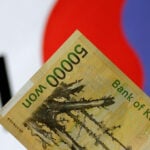By Balazs Koranyi, Francesco Canepa

FRANKFURT (Reuters) -The European Central Bank cut interest rates again on Thursday and signalled a "declining path" for borrowing costs in the months ahead as inflation slows and economic growth in the euro zone falters.
The ECB lowered its deposit rate by 25 basis points to 3.50%, following up on a similar cut in June as inflation is now within striking distance of its 2% target and the domestic economy is skirting a recession.
The move had been widely telegraphed and investor attention has already shifted to what comes next and how ECB decisions will be shaped by the U.S. Federal Reserve's expected start to its own rate cuts next week.
"Our path, of which the direction is pretty obvious - a declining path - is not predetermined, neither in terms of sequence nor in terms of volume," ECB President Christine Lagarde told a press conference.
Sources told Reuters after the meeting that a further rate cut at the ECB's next meeting in October was unlikely barring a major deterioration in the outlook for growth.
The euro zone's central bankers were more likely to wait for their December meeting, when they will have more data and a new round of economic projections, the sources said.
Analysts too said there may be little new data to support an October cut.
"We think the ECB will stick to a quarterly pace of cuts this year – dancing the waltz rather than a quickstep," BlackRock's Ann-Katrin Petersen said.
"Only a further sharp economic deterioration would prompt the ECB to speed up with back-to-back or larger cuts."
Lagarde gave little away at her news conference, simply repeating that the ECB was sticking to a "data-dependent", meeting-by-meeting approach to policy with no pre-commitments.
NEW FORECASTS
She painted a mixed picture of inflation in the euro zone continuing to be sustained by rising wages even as overall labour cost pressures moderated and were absorbed by companies.
She said services sector inflation remained a major worry but that wage growth is moderating and corporate profits are absorbing rapid wage increases.
Lagarde warned that negotiated wage growth will remain high and volatile this year in light of some high-profile pay deals struck recently.
More dovish ECB policymakers, mainly from the bloc's south, have been arguing that recession risks are rising and high interest rates are now restricting growth more than needed, raising the risk that inflation could undershoot the target.
But hawks, who are still in a majority, say the labour market remains too hot for the ECB to sit back, and that underlying price pressures, as evidenced in stubborn services costs, raise the risk inflation could surge again.
New economic forecasts did little to settle the debate.
Quarterly projections from the ECB's staff showed growth this year will be slightly lower than forecast in June while inflation is still seen reaching 2% in the second half of 2025.
That means the argument is likely to be how quickly, not if, the ECB should ease policy.
Hawkish policymakers have made clear that they see quarterly rate cuts as appropriate, since key growth and wage indicators - which inform the ECB's projections - are compiled every three months.
Investors are also divided, with another cut by December fully priced into financial markets but the chance of an interim move in October seen only at 30%.
TECHNICAL RATE CUT
With Thursday's move, the ECB's deposit rate fell by 25 basis points to 3.5%. The refinancing rate, however, was cut by a much bigger 60 basis points to 3.65% in a long-flagged technical adjustment.
The gap between the two interest rates had been set at 50 basis points since September 2019, when the ECB was pumping stimulus into the economy to avert the threat of deflation.
It announced plans in March to narrow the corridor to 15 basis points from Thursday's meeting, to encourage the eventual rekindling of lending between banks.
Such a revival is still years away, so the ECB's move is a pre-emptive adjustment of its operating framework.
For now, banks are sitting on 3 trillion euros of excess liquidity which they deposit with the ECB overnight, making the deposit rate in effect its main policy instrument.
Over time this liquidity should dwindle, pushing banks to borrow again from the ECB at the refinancing rate, traditionally the benchmark for borrowing costs.
Once that happens, the main rate will regain its headline status, while the narrower rate corridor should help the ECB better manage market rates.
(Writing by Mark JohnEditing by Catherine Evans)

 TikTok seeks to reassure U.S. employees ahead of Jan. 19 ban deadline
TikTok seeks to reassure U.S. employees ahead of Jan. 19 ban deadline
 US won't seek charges in unarmed Black motorist Ronald Greene's fatal 2019 arrest
US won't seek charges in unarmed Black motorist Ronald Greene's fatal 2019 arrest
 Euro zone households could increase consumption, ECB chief economist says
Euro zone households could increase consumption, ECB chief economist says
 Foreigners sold South Korean equities last month by most since early 2020
Foreigners sold South Korean equities last month by most since early 2020
 Trump and Biden national and homeland security staff will meet Wednesday for threat exercises
Trump and Biden national and homeland security staff will meet Wednesday for threat exercises
 As fires ravage Los Angeles, Tiger Woods isn't sure what will happen with Riviera tournament
As fires ravage Los Angeles, Tiger Woods isn't sure what will happen with Riviera tournament
 Antetokounmpo gets 50th career triple-double as Bucks win 130-115 to end Kings' 7-game win streak
Antetokounmpo gets 50th career triple-double as Bucks win 130-115 to end Kings' 7-game win streak
 No 97 Laura Siegemund upsets Olympic champion Zheng Qinwen at the Australian Open
No 97 Laura Siegemund upsets Olympic champion Zheng Qinwen at the Australian Open







